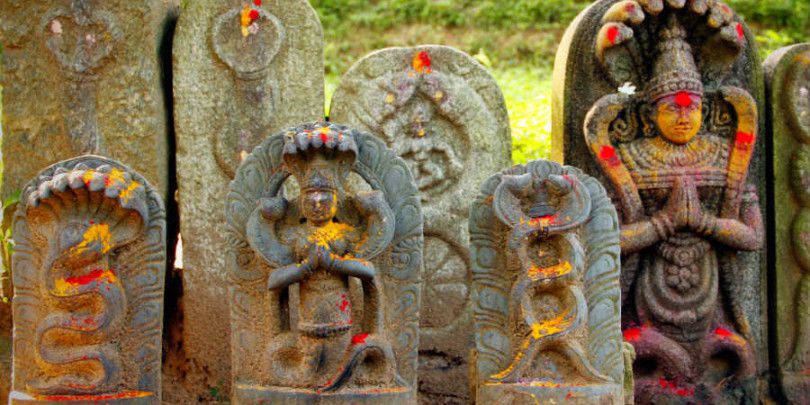 Nag Panchami
Nag Panchami
is a traditional Hindu festival that holds great significance in Indian culture. Celebrated on the fifth day of the bright half of the lunar month of Shravana, it honors the Nagas, or serpent deities. This festival involves various rituals and practices reflecting deep-rooted beliefs in snakes’ protective and benevolent nature. In this blog, we will explore the fascinating stories behind
Nag Panchami, their mythological origins, and their significance in modern times.
The Mythological Origins of Nag Panchami
Nag Panchami
is steeped in mythological tales that emphasize the reverence and awe that snakes command in
Hindu tradition. Several stories highlight the divine and protective qualities of these serpentine beings:
Lord Shiva and the Serpent:
One of the most prominent symbols of
Nag Panchami
is
Lord Shiva, often depicted with a snake around his neck. This snake, Vasuki, signifies power, protection, and the cyclical nature of time. The association of snakes with Shiva underscores their importance and sanctity in Hindu mythology.
Vasuki and the Samudra Manthan:
Another significant story involves Vasuki, the king of serpents, who played a crucial role in the Samudra Manthan (churning of the ocean) to obtain Amrita (the nectar of immortality). Vasuki served as the churning rope, demonstrating the integral role of serpents in cosmic events and their connection to divine acts.
These mythological origins lay the foundation for the worship of serpents and highlight their revered status in Hindu culture. The stories of Lord Shiva and Vasuki are central to the celebrations of
Nag Panchami, reminding devotees of the protective and divine nature of snakes.
The Story of Lord Krishna and Kaliya
One of the most celebrated stories associated with
Nag Panchami
is the tale of
Lord Krishna and his encounter with the venomous serpent Kaliya. This legend is not only thrilling but also rich with symbolic meaning:
The story begins with the mighty serpent Kaliya, who lived in the Yamuna River. His venom was so potent that it poisoned the waters, making them dangerous for all living beings. The people of Vrindavan were deeply troubled by this and sought
divine intervention.
Young Krishna, known for his bravery and divine powers, decided to confront Kaliya. He leaped into the Yamuna and engaged in a fierce battle with the serpent. Krishna’s agility and strength overwhelmed Kaliya, who attempted to coil around him multiple times.
- The Dance on Kaliya’s Hoods:
In a dramatic turn of events, Krishna danced on Kaliya’s multiple hoods, subduing the serpent. The pressure from Krishna’s divine feet forced Kaliya to surrender. The serpent, realizing Krishna’s divinity, begged for mercy.
Moved by Kaliya’s plea and the intercession of the serpent’s wives, Krishna spared his life. He commanded Kaliya to leave the Yamuna and never return, thus purifying the river and restoring peace to Vrindavan.
Significance of the Story:
- Victory of Good Over Evil:
The tale of Krishna and Kaliya symbolizes the triumph of good over evil. Krishna’s victory over the poisonous serpent represents the dispelling of darkness and negativity by divine light and goodness.
This story also highlights the importance of maintaining environmental balance. By driving Kaliya out of the Yamuna, Krishna restored the natural harmony and ensured the well-being of all creatures depending on the river.
- Moral and Spiritual Lessons:
Devotees draw moral and spiritual lessons from this story. It teaches courage, compassion, and the power of divine intervention in overcoming challenges and adversities.
The story of Lord Krishna and Kaliya is celebrated during
Nag Panchami
with great reverence. It serves as a reminder of Krishna’s divine protection and the ever-present struggle between good and evil.
Manasa Devi and Her Worship on Nag Panchami
Manasa Devi, the goddess of snakes, is another central figure in the celebration of
Nag Panchami. She is revered in many parts of India, especially in Bengal and Assam, and her stories are integral to understanding the significance of this festival:
- Introduction to Manasa Devi:
Manasa Devi is believed to be the daughter of sage Kashyapa and Kadru, and the sister of Vasuki, the king of serpents. She is worshipped as the goddess who protects against snake bites and diseases and ensures fertility and prosperity.
- Popular Stories and Legends:
One of the most famous legends associated with Manasa Devi is her conflict with the sage Chand Saodagar. According to the tale, Chand, a devout follower of Shiva, refused to worship Manasa.
Angered by his defiance, Manasa caused the death of his seven sons. However, after numerous trials and tribulations, Chand was finally compelled to acknowledge her divinity. Once he offered her worship, his sons were restored to life, and peace was restored in his household.
- Significance of Manasa Devi’s Worship:
Manasa Devi is invoked to protect families from the dangers of snake bites. Her worship during
Nag Panchami
is believed to placate snakes and prevent them from causing harm.
Devotees also seek her blessings for fertility, prosperity, and the well-being of their families.
- Rituals Dedicated to Manasa Devi:
Devotees perform various rituals, including offering milk, flowers, and prayers to snake images or idols of Manasa Devi.
Manasa Devi’s temples witness special pujas, and folk songs and dances dedicated to her are performed in many regions.
In some areas, women observe fasts and offer prayers to Manasa Devi for the health and safety of their children.
The worship of Manasa Devi during
Nag Panchami
reflects the deep connection between humans and nature. Her legends emphasize the need for harmony with the natural world and respect for its creatures.
The Story of Astika and the Snake Sacrifice
Another significant story associated with
Nag Panchami
is the tale of the sage Astika, who played a crucial role in stopping a massive snake sacrifice (Sarpa Satra). This legend is deeply rooted in the ancient Hindu epic, the Mahabharata:
The story begins with King Janamejaya, the son of Parikshit, who was determined to avenge his father’s death caused by the serpent king Takshaka. In his anger, Janamejaya performed a grand snake sacrifice, or Sarpa Satra, to exterminate all snakes.
Sage Astika, the son of a Brahmin sage Jaratkaru and a Naga woman named Manasa, was a learned and wise young man. Concerned about the imminent destruction of the serpent race, Astika decided to intervene.
He approached the sacrificial ceremony and impressed King Janamejaya with his knowledge and wisdom. Astika pleaded with the king to stop the sacrifice, highlighting the importance of compassion and the needless destruction of living beings.
- The End of the Sacrifice:
Moved by Astika’s eloquence and realizing the senselessness of his vengeance, King Janamejaya agreed to halt the sacrifice. The remaining snakes were spared, and peace was restored between humans and serpents.
Significance of the Story:
The tale of Astika emphasizes the virtues of compassion, wisdom, and the importance of resolving conflicts through understanding and dialogue rather than violence.
This story also highlights the need to protect nature and its creatures. The cessation of the snake sacrifice signifies the importance of maintaining ecological balance and respecting all forms of life.
The legend of Astika is commemorated during
Nag Panchami, symbolizing the end of enmity between humans and snakes. It serves as a reminder of the interconnectedness of all beings and the need for harmony.
The tale of Astika is a powerful narrative that underscores the themes of forgiveness, protection, and the wise use of power. Celebrating this story during
Nag Panchami
reinforces the festival’s message of reverence for nature and the sanctity of life.
Conclusion
Nag Panchami
is a vibrant and spiritually significant festival that celebrates the reverence for snakes in Hindu culture. Through its rich tapestry of myths, rituals, and regional variations, the festival underscores the deep connection between humans and the natural world. The stories of Lord Krishna, Manasa Devi, and Astika convey powerful messages of protection, compassion, and the triumph of good over evil.
As we celebrate
Nag Panchami, we are reminded of the importance of respecting all forms of life and maintaining ecological balance. The festival’s rituals, such as offering milk to snake idols, drawing snake images, and performing special pujas, serve to strengthen our bond with nature and the divine.
By understanding and participating in the cultural practices of
Nag Panchami, we not only honor our heritage but also embrace the spiritual lessons that these ancient stories impart. Let us take this opportunity to reflect on the values of compassion, courage, and respect for the natural world, making
Nag Panchami
a meaningful and enriching experience for all.
Consult
Pt. Pawan Kaushik
an
Astrologer in Delhi
for your queries regarding Vastu, Astrology, and Gemstones.
 Nag Panchami
is a traditional Hindu festival that holds great significance in Indian culture. Celebrated on the fifth day of the bright half of the lunar month of Shravana, it honors the Nagas, or serpent deities. This festival involves various rituals and practices reflecting deep-rooted beliefs in snakes’ protective and benevolent nature. In this blog, we will explore the fascinating stories behind
Nag Panchami, their mythological origins, and their significance in modern times.
Nag Panchami
is a traditional Hindu festival that holds great significance in Indian culture. Celebrated on the fifth day of the bright half of the lunar month of Shravana, it honors the Nagas, or serpent deities. This festival involves various rituals and practices reflecting deep-rooted beliefs in snakes’ protective and benevolent nature. In this blog, we will explore the fascinating stories behind
Nag Panchami, their mythological origins, and their significance in modern times.
 +91 9990176000
+91 9990176000 +91 9999097600
+91 9999097600
 CALENDAR 2025
CALENDAR 2025











